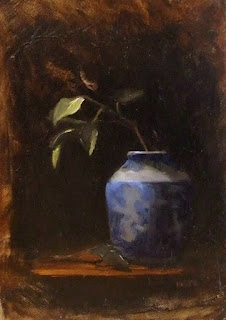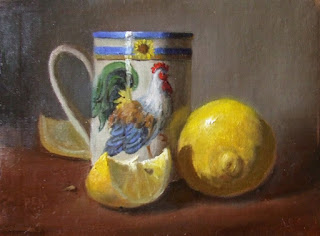
 Here are two small still lifes. I'm using them as an example of a principle about light and shadow and background color.
Here are two small still lifes. I'm using them as an example of a principle about light and shadow and background color.Art instruction and other fun stuff by Debra Pero.

 Here are two small still lifes. I'm using them as an example of a principle about light and shadow and background color.
Here are two small still lifes. I'm using them as an example of a principle about light and shadow and background color. I have always felt that being able to spend time doing what I love so much is a real blessing. I'm quite thankful to paint full time, with all the
I have always felt that being able to spend time doing what I love so much is a real blessing. I'm quite thankful to paint full time, with all the


Color Camp
Not rules, but tools!
As artists, we want to use all the tools at our disposal to help us create good, solid paintings. These 3 sessions are designed to review some basic principles of color that can help us make intelligent choices as we work. Consider these some added “weapons” in your arsenal or tools in your toolbox that you can pull out when you need them!
We won't be trying to complete polished paintings, but rather we'll tackle some exercises to re-enforce each day's lesson. In addition, each day we'll look at a "problem painting" that contains a common error. Heck, it might have several problems! Based on our color lessons, the class will "dissect" the poor painting and decide what's wrong and how to fix it, and then you'll get a chance to create your own "new and improved" version!
Session 1: When You’re Hot, You’re Hot!
Color Temperature: It matters!
Why can’t I use the same colors to paint an orange that is sitting on my kitchen table as an orange sitting outside on my deck railing? In other words, how does outside light differ from inside light? One word: COLOR TEMPERATURE! (okay, okay, that's two words). Tip: This might be very useful info if you want to paint still life or landscape... or interiors.. or figures inside or outside... or old cars rusting under a tree... or maybe a package of neon gummi worms....
Where is this orange? Outside or inside?
Session 2. Good Morning, Sunshine!
Portraying Time of Day in Your Landscape
What’s the difference between morning light and late afternoon light? Is there a difference? How do we make our paintings look like morning, noon, or evening?
Look at this poor painting. I can't tell what time of day it's supposed to be. And there are some other real errors. Should we shoot it and put it out of its misery? Wait, there's hope! Come find out how we can correct and improve this baby.
Session 3. Way Over Yonder…..
The effects of Atmosphere on Color.
When is a red barn not red? What happens to autumn foliage on that distant hillside?
This painting has a problem. Actually, it has several glaring problems, and these problems are common errors that can be avoided by understanding some simple principles of color and design.
Do you know how to fix this painting?
Well, come join us for some fun as we focus on color! There are about 3 spots left in the class.